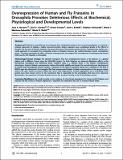Por favor, use este identificador para citar o enlazar a este item:
http://hdl.handle.net/10261/38715COMPARTIR / EXPORTAR:
 SHARE SHARE
 CORE
BASE CORE
BASE
|
|
| Visualizar otros formatos: MARC | Dublin Core | RDF | ORE | MODS | METS | DIDL | DATACITE | |

| Título: | Overexpression of Human and Fly Frataxins in Drosophila Provokes Deleterious Effects at Biochemical, Physiological and Developmental Levels |
Autor: | Navarro, Juan A.; Llorens, José V. CSIC ORCID; Soriano, Sirena; Botella, José A.; Schneuwly, Stephan; Martínez-Sebastián, María J.; Moltó, María D. | Fecha de publicación: | 11-jul-2011 | Editor: | Public Library of Science | Citación: | PLoS ONE 6(7):e21017 (2011) | Resumen: | BACKGROUND: Friedreich's ataxia (FA), the most frequent form of inherited ataxias in the Caucasian population, is caused by a reduced expression of frataxin, a highly conserved protein. Model organisms have contributed greatly in the efforts to decipher the function of frataxin; however, the precise function of this protein remains elusive. Overexpression studies are a useful approach to investigate the mechanistic actions of frataxin; however, the existing literature reports contradictory results. To further investigate the effect of frataxin overexpression, we analyzed the consequences of overexpressing human (FXN) and fly (FH) frataxins in Drosophila. METHODOLOGY/PRINCIPAL FINDINGS: We obtained transgenic flies that overexpressed human or fly frataxins in a general pattern and in different tissues using the UAS-GAL4 system. For both frataxins, we observed deleterious effects at the biochemical, histological and behavioral levels. Oxidative stress is a relevant factor in the frataxin overexpression phenotypes. Systemic frataxin overexpression reduces Drosophila viability and impairs the normal embryonic development of muscle and the peripheral nervous system. A reduction in the level of aconitase activity and a decrease in the level of NDUF3 were also observed in the transgenic flies that overexpressed frataxin. Frataxin overexpression in the nervous system reduces life span, impairs locomotor ability and causes brain degeneration. Frataxin aggregation and a misfolding of this protein have been shown not to be the mechanism that is responsible for the phenotypes that have been observed. Nevertheless, the expression of human frataxin rescues the aconitase activity in the fh knockdown mutant. CONCLUSION/SIGNIFICANCE: Our results provide in vivo evidence of a functional equivalence for human and fly frataxins and indicate that the control of frataxin expression is important for treatments that aim to increase frataxin levels. | Descripción: | 10 pages, 5 figures. 21779322[PubMed] PMCID: PMC3136927 | Versión del editor: | http://dx.doi.org/10.1371/journal.pone.0021017 | URI: | http://hdl.handle.net/10261/38715 | DOI: | 10.1371/journal.pone.0021017 | E-ISSN: | 1932-6203 |
| Aparece en las colecciones: | (IBV) Artículos |
Ficheros en este ítem:
| Fichero | Descripción | Tamaño | Formato | |
|---|---|---|---|---|
| PlosOne 2011 Llorens.pdf | 595,61 kB | Adobe PDF |  Visualizar/Abrir |
CORE Recommender
PubMed Central
Citations
22
checked on 14-abr-2024
SCOPUSTM
Citations
28
checked on 17-abr-2024
WEB OF SCIENCETM
Citations
28
checked on 29-feb-2024
Page view(s)
372
checked on 18-abr-2024
Download(s)
249
checked on 18-abr-2024
Google ScholarTM
Check
Altmetric
Altmetric
Artículos relacionados:
NOTA: Los ítems de Digital.CSIC están protegidos por copyright, con todos los derechos reservados, a menos que se indique lo contrario.
